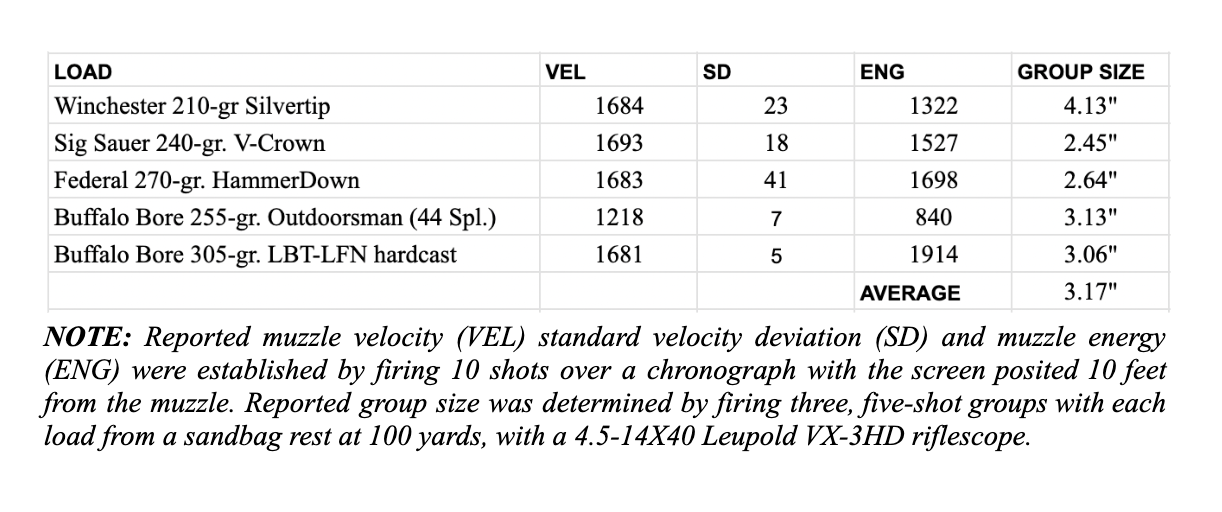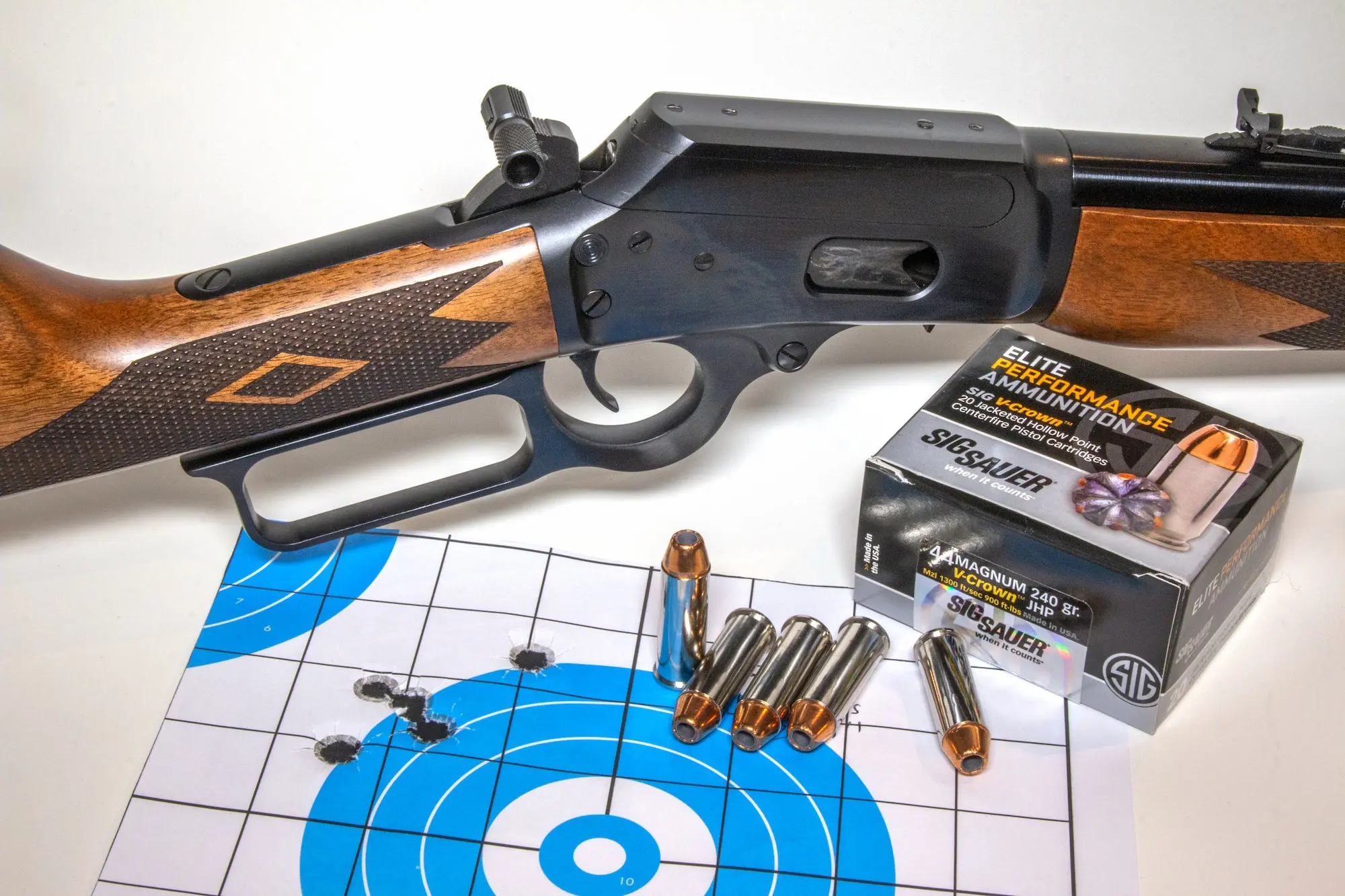_We may earn revenue from the products available on this page and participate in affiliate programs. Learn more ›
_
One of Marlin’s most desired lever guns has always been the 1894. This was partly due to its compact flat top receiver and the solid, slab-sided bolt that kept the action internals free from debris. But it was mainly because the 1894 was commonly chambered for revolver cartridges. As a lever-action carbine, they bridged the gap between a rifle cartridge and a handgun, and you could carry a rifle and revolver that used the same ammunition. The 1894 has been chambered in everything from the 218 Bee to the 45 Colt, and a few were even offered in 32 H&R Magnum and 41 Magnum. However, in 1969 Marlin introduced the 1894 in 44 Magnum, and this is the cartridge the new Ruger-owned Marlin chose to first offer in their recent reintroduction of the 1894.
I received one of the first of these rifles off the assembly line and recently put it through the wringer to see if was as good as or maybe better than the pre-Remington 1894s known as “JM” Marlins, or the 1894s offered when Marlin was owned by Remington that are often called “Remlins.” Over the course of two days, I fired 300 rounds from the bench and from field shooting positions. As the saying goes, “I ran it like I stole it” because I wanted to see if it would live up to what shooters expect from a Marlin.
Marlin 1894 Specifications

Manufacturer: Marlin
Model:1894 Classic, #70401
Chambering: 44 Remington Magnum/44 Special
Barrel: 20.25 inches, 1 in 20” right-hand twist, six grooves, cold hammer-forged alloy steel
Finish: Satin blued
Stock: American black walnut
Length of Pull: 13.63 inches
Length: 37.75 inches
Capacity: 6+1
Sights: Semi-buckhorn rear, brass bead front with hood
Weight: 6 pounds, 4.7 ounces, with hammer spur installed
Trigger: 4.0 to 4.75 pounds (as tested)
MSRP: $1,239
First Impressions
The new 1894 is a faithful rendition of the 1894 shooters and hunters have come to love. What impressed me most about this rifle was the quality of the bluing; it was black as the dirt under a coal miner’s fingernail. The top and bottom of the action are matte, but the sides of the action, barrel, and lever are polished beautifully. The wood-to-metal fit and the quality of the walnut stock were also exceptional. And I liked how the forend has been thinned—it’s not as thick as the forends on the 1894s Marlin produced when they were owned by Remington.

Cartridges were easy to load in the Marlin 1894, even up to its six-round capacity. Richard Mann
The rifle came with an optional hammer spur which is secured in place with a single screw and is almost a must for easy hammer access if you plan to mount a riflescope. Sling swivel studs are standard, with the rear stud about three inches forward of the toe of the stock, and the front stud is integral to the barrel band around the forend. A thin brown recoil pad caps off the butt and is separated from the wood with a black band. The walnut stock is also machine checkered at the wrist and on the forend, and just as with all the new Ruger-Marlins, there’s a white circle with a red dot on the belly of the stock.
Shooting Results
Pros
Perfectly balanced
Very nice fit and finish
Trim forearm
Easy to load
Cons
Crisp trigger but slightly inconsistent.
I’ve spent a lot of time with Marlin 1894s. I had one in 32-20 Winchester that would wear a quarter out at 50 yards. Another in 32 H&R Magnum shot better than that. But those were exceptions. Two-inch groups at 100 yards with 1894s are generally better than average, and in my experience, the larger the caliber, the less precision you’ll see.
All the bench, I tested the rifle with a Leupold VX-3HD 4.5-14X riflescope, which I’d never mount to a rifle like this for real-world use. The trigger was extremely crisp, but pull weight varied a tad, ranging from between four to five pounds. The pull weight combined with the inconsistency probably opened groups slightly. Still, the 1894 shot reasonably well given what can be expected from the platform. For 15 five-shot groups at 100 yards (75 shots) from a sandbag rest, it averaged right at three inches. The best 100-yard group was fired with the Sig Sauer 240-grain V-Crown load, and it measured 2.22 inches. Most of the 50-yard groups with open sights were in the 1.5- to 2.5-inch range.

Richard Mann
After bench testing, I conducted a lot of offhand shooting from 25 to 100 yards using open sights. From the high ready, at 25 yards I could put three shots into an eight-inch circle in just under four seconds. Snap shots at an eight-inch circle at 50 yards averaged 2.25 seconds, and about 4 seconds for snap shots at 100 yards on a 16-inch plate. But though it is traditional, I’m not a fan of the traditional barrel-mounted rear sight and hooded brass bead front sight on this rifle. I’d much prefer an aperture rear sight and a striped post front sight like on Marlin’s current 1895 SBL and Trapper rifles. Of course, the receiver is drilled and tapped, so mounting an XS aperture sight, a riflescope, or even a miniature reflex sight, is easy.
The Buffalo Bore 44 Special load cycled through the rifle like butter, but there were feeding issues with the Buffalo Bore Heavy 305-grain hardcast LBT-LFN bullet. If you ran the action moderately, this load fed fine. If you racked the action like you were trying to start a broke-ass chainsaw, sometimes this load would hang up, and you’d have to try again with a little less gusto. This is not uncommon. Finding an 1894 in 44 Magnum that will perfectly feed every load you can shove in it is tough. This is because the 44 Magnum was designed for revolvers and uses a wide range of bullet shapes. Initially, extraction was also a bit stiff with the heavier bullet loads, but this eased after firing more rounds.

The best group fired from the bench at 100 yards was with the 240-grain Sig Sauer load. Richard Mann
Parting Shots
Jerry Dove, my personal gunsmith who runs Dove Custom Guns
, is a lever-action addict and has more experience with them than anyone I know. After he looked over the new 1894 Classic, he said he was impressed, but added, “I hope it will cycle well. 1894s in 44 Magnum are notorious for being finicky.” This one performed better than any 1894 in 44 Magnum I’ve fired in the past, and my only real complaint was the trigger. It was not as good as those on other new Marlins—that I previously tested—which includes all three new 1895s and the new 336.
Overall the new 1894 is a good-looking rifle. It balances right, feels light and nimble in hand, and shoulders with a snap. It also feels like it’d be right at home while prowling a hardwood ridge for whitetails, tucked in a saddle scabbard on a horseback hunt, or leaning against the wood pile at a tent camp in grizz country. And in close quarters or over a feeder, it ought to be hog-smacking handy. The new Marlin continues to impress. The original 1894 was offered in 12 chamberings, and I wonder which one they’ll give us next.
**Read Next: Is the Ruger LC Carbine in 5.7x28mm the Ultimate Truck Gun?
**
A Note on Price
Many have complained that the new Marlins are too expensive. I think this is partly because shooters often compare them to modern and very affordable bolt-action rifles, which are much less complicated to build and are often outfitted with a plastic stock. You may not be splitting dimes with a lever gun, but they are the classic American rifle, and nothing can compare with them for ease of carry and fast action. To put things in perspective, consider that a new comparable Henry lever action rifle retails for $1,057 and prices for a used “JM” or “Remlin” 1894 in good condition will generally start around $1,500.
![Field & Stream [dev]](https://images.ctfassets.net/fbkgl98xrr9f/1GnddAVcyeew2hQvUmrFpw/e4ca91baa53a1ecd66f76b1ef472932b/mob-logo.svg)





